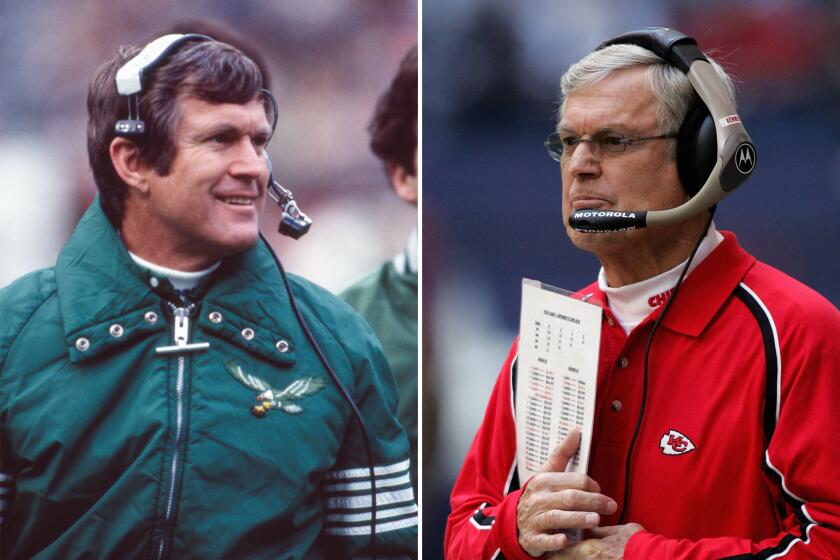Some Good Ol’ Boys Circumvent the Rules
- Share via
DAYTONA BEACH, Fla. — Richard Petty used to say, “If you ain’t cheatin’ a little, you ain’t competitive.”
That was two or three decades ago, when Petty was winning seven Winston Cup championships and seven Daytona 500s, but judging by the number of fines levied by NASCAR during Daytona’s Speed Weeks, little has changed in stock car racing’s highly competitive world.
In NASCAR’s formative years, circumventing rules was almost a game between crew chiefs and racing officials, but as the sport became more sophisticated, the rule enforcers got tougher.
Gary Nelson, a one-time crew chief from Redlands, Calif., with a history of stretching rules, was hired as chief enforcer in 1992.
As Winston Cup series director, he has 30 inspectors who check every detail of the chassis, engine and aerodynamic controls.
In the last week, they have levied fines of $90,000 against four teams and put their crew chiefs on probation.
Legendary car owner Junior Johnson was the hardest hit with a NASCAR record $45,000 fine for having a loose part in the intake manifold--rules require it be welded--on Brett Bodine’s Ford. The car was also barred from first-day qualifying.
Car owner Bill Davis and driver Randy Lajoie were fined a combined $35,000 when inspectors found an electric motor that operated a hydraulic pump, enabling the driver to lift and lower the rear deck lid, which affected the car’s aerodynamics.
Owner-driver Joe Nemecheck was fined $5,000 for making illegal ridges in a filter to increase air flow, and crew chief Jeff Hammond was fined $5,000 when 18 pounds of loose metal was found in the driver’s compartment.
“The hydraulic pump was one of the most ingenious devices we’ve run across,” Nelson said. “It was very sophisticated. Because it was operated by the driver, we fined him $10,000.”
Nelson said the amount of the fines will escalate if the cheating--doesn’t stop.
“Last July, we had some violations of the roof-flap rule, and we fined some guys $5,000,” he said. “At that time, we said that if that wasn’t enough, we would raise the fines. The violations haven’t stopped, so this week’s fines indicate our resolve.
“Somehow, we’ve got to get their attention. Our main concerns are safety, level of competition and cost to car owners. Safety is primary. Last year, when we found holes drilled in one team’s roll bars (to reduce weight) we sent the team home.”
The incident, which occurred at Richmond, Va., last September, involved the Stavola brothers’ No. 8 Ford.
Cheating stories are numerous in NASCAR. One of the favorites concerns the time Smokey Yunick pushed his car, presumably out of fuel, to the inspection area after competitors had complained he had a secret fuel compartment. When officials found nothing wrong, Yunick climbed in the car, turned on the ignition and drove off.
Johnson was caught with an illegal engine at Charlotte in 1991 and was suspended for 12 weeks. The suspension was later reduced to four weeks, but his car continued to race anyway, with his ex-wife, Flossie, listed as owner.
In 1983, Petty was fined $35,000 and had 104 Winston Cup points deducted after winning the Miller 500 at Charlotte with an oversized engine. His car also had left-side tires on the right side, another violation.
“As a former crew chief, I can draw on past experience and understand the crew chief’s side of the story,” Nelson said. “I know they can wake up sometimes in the middle of the night and come up with an idea. It’s a never-ending struggle.”
As crew chief for Bobby Allison when Allison won the Winston Cup championship in 1983, Nelson was suspected of having a secret fuel supply, but NASCAR officials were unable to prove it.
“I heard someone say that you had to hire a bank robber to know how to catch one, but I don’t look at it that way,” Nelson said. “This sport is changing so fast, the things I was thinking about doing are ancient history.
“They’re coming up with new ideas to stay current with the new technology. If I say I know everything that’s going on inside the engine or the brakes or whatever because I was a crew chief in 1991, well, that’s just not true.
“If we tried to write a rule book for everything they could violate and a fine for violating that rule, the book would be as big as the biggest dictionary you’ve ever seen. We don’t know what the next twist or turn will be, but we hope to be ready for it.”
Dan Pardus can attest to the extremes NASCAR takes to ensure that rules are not broken.
When he wanted to carry a teddy bear with him during a race, NASCAR officials demanded to inspect it. Reportedly, they feared Pardus might have stuffed it with a bottle of nitrous oxide, which, when added to gasoline, makes a race car faster.
To make sure the teddy bear passed inspection, Pardus outfitted it with a fire suit and fireproof shoes before strapping it into the car.
More to Read
Go beyond the scoreboard
Get the latest on L.A.'s teams in the daily Sports Report newsletter.
You may occasionally receive promotional content from the Los Angeles Times.










